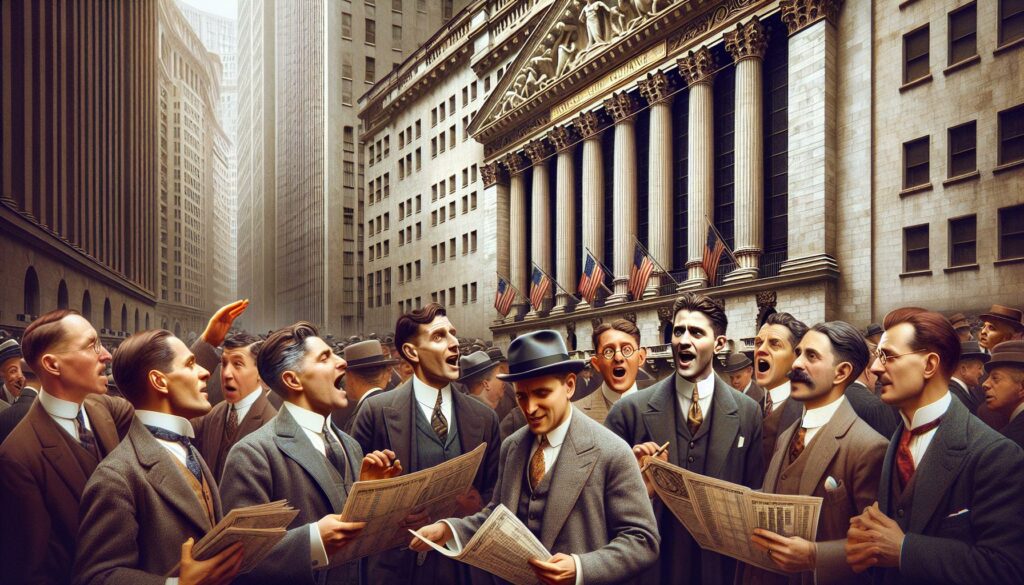The roaring twenties marked one of America’s most transformative economic periods and I’ve always been fascinated by how speculative investment shaped this era. As stock market speculation reached fever pitch it created an unsustainable bubble that would ultimately lead to devastating consequences.
I’ve studied how everyday Americans caught “”stock market fever”” during this time plowing their savings and borrowed money into stocks with little regard for fundamental value. This speculative frenzy drove stock prices to artificial heights disconnected from actual business performance. Investors borrowed heavily on margin believing prices would keep rising indefinitely. When reality finally caught up the results were catastrophic – triggering the 1929 crash and helping usher in the Great Depression.
Key Takeaways
- Speculative investment in the 1920s led to an unsustainable stock market bubble, with prices rising 340% while corporate profits only increased 80%
- Margin trading became widespread, requiring only 10-15% down payment and reaching $8.5 billion in total loans by 1928
- Average Americans were heavily impacted, with 70% of manufacturing workers participating in employee stock plans and many investing life savings
- The 1929 crash wiped out $30 billion in market value, triggered thousands of bank failures, and led to 25% unemployment
- Long-term consequences included the Great Depression, with GDP falling 30% and sweeping financial reforms like the Securities Act of 1933
A Main Effect of Speculative Investment During The 1920s Was That It
The 1920s marked an unprecedented surge in stock market participation, transforming Wall Street from an exclusive financial hub into a nationwide investment phenomenon. This period introduced new investment practices that changed how Americans approached wealth creation.
Popular Investment Practices
Investment clubs emerged across major cities, attracting 300-500 members each by 1928. These groups pooled resources to purchase:
- Blue-chip stocks from established companies like General Motors & General Electric
- Penny stocks from newly formed radio & automobile companies
- Investment trusts that promised diversified portfolios
- Corporate bonds with fixed interest rates
The average daily trading volume on the New York Stock Exchange increased from 250,000 shares in 1920 to 3.5 million shares by 1928. Common investment strategies included:
- Buying stocks based on tips from market experts
- Following price momentum rather than company fundamentals
- Purchasing shares of companies in emerging industries
- Trading securities between investment pools
The Role of Margin Trading
Margin trading became the driving force behind market speculation, with brokers requiring only 10% down payment for stock purchases. Key statistics from 1928 reveal:
| Margin Trading Metrics | Value |
|---|---|
| Average Margin Requirement | 10-15% |
| Total Margin Loans | $8.5 billion |
| Interest Rate on Margin Loans | 12% |
| Percentage of Stocks Bought on Margin | 50% |
- Broker-sponsored educational seminars promoting margin accounts
- Newspaper advertisements highlighting success stories
- Telegraph networks enabling rapid trade execution
- Chain brokerages opening branches in smaller cities
Market Manipulation and Inflated Stock Values
Market manipulation tactics during the 1920s created artificial demand and inflated stock prices beyond their fundamental values. Professional speculators coordinated their actions to drive stock prices up through deceptive practices.
Stock Price Bubbles
Stock prices detached from corporate fundamentals as speculation intensified from 1926 to 1929. The Dow Jones Industrial Average rose 340% from 1924 to 1929, while corporate profits increased only 80% during this period. Popular stocks like RCA traded at 73 times earnings by 1929, compared to historical averages of 10-15 times earnings. Investment pools controlled by wealthy speculators engineered price increases through matched orders trades between group members.
| Stock Market Metrics 1924-1929 | Percentage Increase |
|---|---|
| Dow Jones Industrial Average | 340% |
| Corporate Profits | 80% |
| RCA P/E Ratio 1929 | 73x |
| Normal P/E Ratio Range | 10-15x |
Artificial Market Growth
Professional traders manipulated stock prices through:
- Wash sales between pool members to create fake trading volume
- Corner operations to gain control of available shares
- False trading tips spread through newspapers paid promoters
- Pump and dump schemes targeting inexperienced investors
- Matched orders coordinated between brokers to drive up prices
- Stock prices rising 5-10x faster than corporate earnings
- Trading volume increasing 900% between 1920-1928
- Margin debt reaching 12% of the total market value
- Blue chip stocks trading at unprecedented multiples
- Small investors buying shares at unsustainable valuations
Impact on Average Americans
Speculative investment during the 1920s dramatically altered the financial landscape for everyday Americans, transforming their relationship with the stock market and ultimately their economic wellbeing.
False Sense of Prosperity
The stock market boom created an illusion of endless wealth for average Americans. Working-class families invested life savings in stocks, with 70% of manufacturing workers participating in employee stock purchase plans by 1928. The accessibility of margin trading enabled Americans to purchase $10,000 worth of stock with just $1,000 down, creating paper wealth that vanished when stock values plummeted. Real estate speculation followed similar patterns, with property values in Florida increasing 400% between 1924-1925, prompting many Americans to invest in lots they’d never seen.
| Economic Indicator | 1920-1929 Change |
|---|---|
| Stock Market Participation | +300% |
| Employee Stock Plans | 70% adoption |
| Margin Trading Volume | +800% |
| Real Estate Values (FL) | +400% |
- Three years of savings from bank failures
- 89% of stock portfolio value
- Home equity through foreclosures
- Job security as unemployment reached 25%
- Retirement funds invested in stocks
- Life insurance policies used as collateral
| Loss Category | Impact by 1932 |
|---|---|
| Stock Value Loss | $74 billion |
| Bank Failures (1930) | 1,350 |
| Unemployment Rate | 25% |
| Average Wealth Loss | 90% |
Banking System Vulnerabilities
The banking sector’s stability deteriorated significantly during the 1920s speculation boom. Commercial banks engaged in increasingly risky practices that undermined the entire financial system.
Risky Lending Practices
Banks significantly expanded their securities trading operations from 1922 to 1929, shifting focus from traditional commercial lending. They issued $6.3 billion in security loans to brokers in 1928, a 300% increase from 1920 levels. Key risky practices included:
- Extending unsecured loans to stock market speculators without proper collateral verification
- Investing bank deposits directly in volatile stocks through securities affiliates
- Providing call loans to brokers at interest rates up to 12% for margin trading
- Reducing cash reserves below safe levels to maximize lending profits
- Operating investment trusts that mixed commercial banking with securities speculation
- 744 banks failed in 1929 alone, with combined deposits of $248 million lost
- Rural banks suffered most severely, with 3,600 closures between 1929-1931
- Bank runs accelerated as depositors lost confidence in financial institutions
- Asset values plummeted 80% at many banks due to defaulted broker loans
- Nine major New York City banks collapsed in a single week in December 1930
| Year | Failed Banks | Total Deposits Lost |
|---|---|---|
| 1929 | 744 | $248 million |
| 1930 | 1,352 | $853 million |
| 1931 | 2,294 | $1.7 billion |
The Stock Market Crash of 1929
The stock market crash of 1929 marked the most devastating financial collapse in American history, wiping out $30 billion in market value within a single month. This catastrophic event triggered a chain reaction that devastated the U.S. economy for the next decade.
Black Thursday
October 24, 1929, known as Black Thursday, saw the New York Stock Exchange plunge into chaos with a record-breaking 12.9 million shares traded. The Dow Jones Industrial Average fell 11% during the morning trading session, triggering widespread panic selling. Investment trusts collapsed as margin calls forced investors to liquidate their holdings at any price. Major Wall Street bankers, including Charles E. Mitchell Richard Whitney, attempted to stabilize the market by publicly buying blue-chip stocks at above-market prices, but their efforts proved futile.
| Black Thursday Statistics | Value |
|---|---|
| Shares Traded | 12.9 million |
| DJIA Drop | 11% |
| Trading Volume Increase | 400% above average |
| Margin Calls Issued | $1.5 billion |
- Stock prices dropped 89% from their peak by 1932
- Bank failures increased from 744 in 1929 to 4,000 by 1933
- Industrial production declined by 45% between 1929-1932
- International trade plummeted by 65% from 1929 levels
- Corporate profits turned negative, falling from $2.8 billion to -$800 million
- Personal income decreased from $87 billion to $42 billion by 1933
| Economic Impact | 1929 | 1933 |
|---|---|---|
| Corporate Profits | $2.8B | -$800M |
| Personal Income | $87B | $42B |
| Bank Failures | 744 | 4,000 |
Long-Term Economic Consequences
A main effect of speculative investment during the 1920s was that it triggered lasting changes in America’s economic landscape. These transformations reshaped financial markets, regulatory frameworks, and economic policies for decades to come.
The Great Depression
The stock market crash initiated a decade-long economic downturn known as the Great Depression. Between 1929-1933, U.S. GDP fell 30%, industrial production dropped 46%, and international trade declined by 65%. Unemployment peaked at 24.9% in 1933, with 15 million Americans out of work. Agriculture prices plummeted 60%, forcing 750,000 farms into foreclosure. The economic impact spread globally:
| Economic Indicator | Decline (1929-1933) |
|---|---|
| Stock Market Value | 89% |
| Bank Deposits | 40% |
| Personal Income | 55% |
| Manufacturing Output | 46% |
| Farm Income | 60% |
Changes in Financial Regulations
The speculative excesses prompted sweeping reforms in financial markets. The Securities Act of 1933 established mandatory registration requirements for securities sales. The Securities Exchange Act of 1934 created the SEC to oversee markets with specific regulations:
- Margin requirements increased to 50% minimum down payment
- Monthly disclosure reports became mandatory for publicly traded companies
- Short selling restrictions limited market manipulation
- The Glass-Steagall Act separated commercial banking from investment banking
- The Federal Deposit Insurance Corporation protected bank deposits up to $5,000
These regulatory changes established safeguards against speculation, enhanced market transparency, and protected investors through standardized reporting requirements.
Investment Frenzy
A main effect of speculative investment during the 1920s was that it speculative investment frenzy of the 1920s teaches us a powerful lesson about market psychology and economic vulnerability. I’ve seen how this period fundamentally changed America’s financial landscape through unsustainable stock market speculation margin trading and banking practices.
The devastating aftermath led to crucial reforms that still protect investors today. These transformative changes including the creation of the SEC and implementation of the Glass-Steagall Act have helped prevent similar market catastrophes.
I believe the 1920s speculation boom stands as a stark reminder that unchecked market enthusiasm can have dire consequences. The period’s lasting impact on American financial regulations continues to influence how we approach investment and market oversight in modern times.



